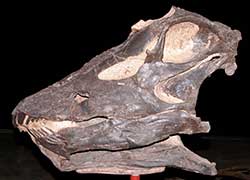Diplodocus
(dip-LOH-doh-kus)
| Quick Facts | |
|---|---|
| Name Meaning: | Double Beam |
| Distribution: | Colorado, Montana, Utah, Wyoming, USA |
| Time Period: | Jurassic, 155-145 Ma |
| Length: | 87 feet (27m) |
| Weight: | 13 tons |
| Diet: | Leaves |
| Habitat: | Plains |
| Linnaean Classification | |
| Kingdom: | Animalia |
| Phylum: | Chordata |
| Class: | Sauropsida |
| Superorder: | Dinosauria |
| Order: | Saurischia |
| Suborder: | Sauropodomorpha |
| Family: | Diplodocidae |
| Genus: | Diplodocus |
| Cladistic Classification | |
| |

History
The Diplodocus was first discovered in 1877 by S. W. Williston. It was described one year later by Othiel Marsh. Diplodocus are very common in the Upper Morrison Formation, a geographical section of marine and alluvial sediments representing time periods approximately 150 to 147 million years ago. The Morrison Formation was also home to many giant sauropods of the time including Camarasaurus, Barosaurus, Apatosaurus, and Brachiosaurus.Description
 |
| Diplodocus Skull. |
Lifestyle
We currently have no evidence about the nesting habits of the Diplodocus, but we do know that they had a rapid growth rate, growing into sexual maturity perhaps as early and 10 years. When first discovered, paleontologists thought that the Diplodocus lived in water because of the high placement of the nasal cavities in the skull. However, recent studies do not support this because the water pressure on its lungs would have been too much for the Diplodocus to handle. Like other dinosaurs it was thought to have legs splayed out to the sides instead of standing upright. However, if this were the case then the Diplodocus would have needed a large ditch to drag its body in. It probably stripped branches of their leaves due to its oddly slanted teeth and jaw shape. The neck and head were probably carried in a general horizontal position but would have had the ability to raise its neck to at least a 45-degree angle to its body. The tail was used as a counterbalance for the head and may have also been used as a defense by making loud whip cracking sounds.
Copyright © 2005-2010 Calvin & Rosanna Hamilton. All rights reserved.